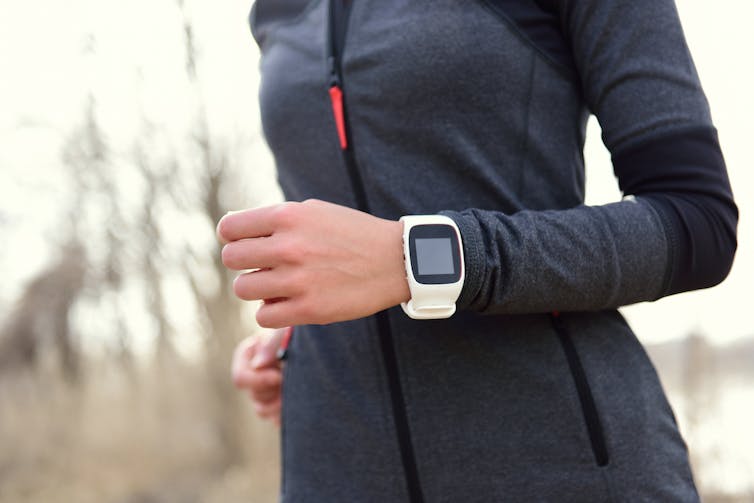When it comes to Fitbit's 10,000 steps, one size doesn't fit all
Author: Mark Orme, Loughborough University
When it comes to Fitbit's 10,000 steps, one size doesn't fit all

Mark Orme, Loughborough University
The rise of wearable fitness technology is something of a paradox. The surge in popularity of devices that monitor the amount of exercise you do suggest more people than ever are interested in maintaining regular fitness regimes. Just witness the success of the company behind fitness tracking bracelet Fitbit, which investors have just deemed worth US$4.1bn (£2.6bn) after it floated on the stock market. Yet this comes at a time when physical inactivity has reached levels of global pandemic proportion.
This shows how important it is that the public understand and follow science-based health and behaviour advice. The advantage of wearable fitness technology is that it can provide a way for personalised data to shape how much extra physical activity (including exercise) a person needs to do and when.
The well-publicised recommendation to take “10,000 steps a day” is a perfect example. The figure actually originates from Japanese walking clubs and a marketing slogan for pedometers more than 40 years ago. But step counts have been shown to provide a reliable measure of daily activity in healthy adults. They also provide a meaningful everyday metric that allows individuals to self-monitor their physical activity and walking.
The self-monitoring (observing and evaluating one’s behaviour) and goal setting that come with devices like Fitbit are two of the most complementary and potent ways of changing people’s physical activity behaviour. Combining activity trackers, which allow the wearer to observe their steps in real-time and review at their leisure, with goals such as walking 10,000 steps can make people more motivated and more able to increase or maintain their physical activity levels.
More is better
But it is important to realise that 10,000 steps is not a magic threshold. Increasing our time spent walking, regardless of our starting point, is beneficial. At a population level, the biggest changes to health come from improvements at the lower end of the scale. For example, going from 2,000 steps to 4,000 steps will produce greater overall health benefits than going from 4,000 steps to 6,000 steps. At the same time, the more active we are (or more steps we take) each day the better. So taking 6,000 steps a day is still better for your health than 4,000 steps.
With the emergence of a large number of activity trackers, a new challenge has emerged for the promotion of 10,000 steps. The data behind the recommendation was derived from pedometers which are conventionally worn on the hip. Today, manufacturers tend to produce devices for the wrist because they are more comfortable and convenient for self-monitoring.

But devices worn on the extremities will pick up extra movement compared with hip-worn monitors. That means they may miscount other large movements from daily life, such as sweeping the floor or doing the dishes, as steps. As a result, it is important for people to be aware that wrist-worn devices may inflate their daily step count.
In general, we should remember that, when it comes to physical activity, “some is good but more is better”. But we can also use step counters to tackle the problems of long periods of sedentary behaviour (sitting). For example, many of us will have particular times of the day (perhaps during work or during the evening) where we spend most of our time sitting. By continuing to accumulate steps during these periods we can simultaneously target reductions in our sitting time.
By monitoring our sitting behaviours alongside the aim of achieving 10,000 steps, we can start to break up these extensive sedentary periods with bouts of activity. Not only would we take more steps but also we would spend less time sitting for long periods. Some fitness trackers have started implementing this idea by prompting the wearer when they have been inactive for “too long”.
Lifestyle medicine
The difficulty with physical activity promotion is that one size doesn’t necessarily fit all. For individuals with health conditions that impact their ability to accumulate higher levels of physical activity, such as rheumatoid arthritis or severe respiratory impairment, it is likely to be more feasible to prescribe lower step-count targets to begin with.
People who spend a lot of time sitting during work, such as taxi drivers, will likely need to accumulate higher step counts to help compensate for the negative effects of prolonged sitting. This has contributed to the concept of “lifestyle medicine” (preventing and managing health conditions through lifestyle choices).
If we can get the message out that physical activity trackers need to be combined with this kind of individual goal setting, then we might see both increases in physical activity and reductions in sitting across populations.![]()
Mark Orme, PhD Candidate, Loughborough University
This article is republished from The Conversation under a Creative Commons license. Read the original article.







